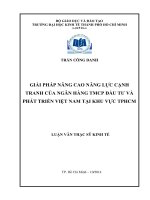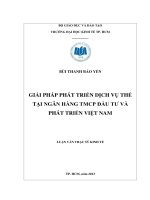(Luận văn thạc sĩ) nâng cao khả năng cạnh tranh về dịch vụ thẻ của ngân hàng TMCP đầu tư và phát triển việt nam (BIDV) trong kỷ nguyên số
Bạn đang xem bản rút gọn của tài liệu. Xem và tải ngay bản đầy đủ của tài liệu tại đây (1.34 MB, 97 trang )
ĐẠI HỌC QUỐC GIA HÀ NỘI
KHOA QUẢN TRỊ VÀ KINH DOANH
---------------------
ĐẶNG THỊ HẢI YẾN
ENHANCING THE COMPETITIVENESS
OF BIDV'S CARD SERVICES IN THE DIGITAL ERA
NÂNG CAO KHẢ NĂNG CẠNH TRANH
VỀ DỊCH VỤ THẺ CỦA NGÂN HÀNG TMCP ĐẦU TƯ
VÀ PHÁT TRIỂN VIỆT NAM (BIDV) TRONG KỶ NGUYÊN SỐ
LUẬN VĂN THẠC SĨ QUẢN TRỊ KINH DOANH
HÀ NỘI - 2019
ĐẠI HỌC QUỐC GIA HÀ NỘI
KHOA QUẢN TRỊ VÀ KINH DOANH
---------------------
ĐẶNG THỊ HẢI YẾN
ENHANCING THE COMPETITIVENESS
OF BIDV'S CARD SERVICES IN THE DIGITAL ERA
NÂNG CAO KHẢ NĂNG CẠNH TRANH
VỀ DỊCH VỤ THẺ CỦA NGÂN HÀNG TMCP ĐẦU TƯ
VÀ PHÁT TRIỂN VIỆT NAM (BIDV) TRONG KỶ NGUYÊN SỐ
Chuyên ngành: Quản trị kinh doanh
Mã số: 60 34 01 02
LUẬN VĂN THẠC SĨ QUẢN TRỊ KINH DOANH
NGƯỜI HƯỚNG DẪN KHOA HỌC: PGS.TS. HỒNG ĐÌNH PHI
HÀ NỘI - 2019
DECLARATION
The author confirms that the research outcome in the thesis is the result
of author’s independent work during study and research period and it is not
yet published in other’s research and article.
The other’s research result and documentation (extraction, table, figure,
and other document) used in the thesis are cited properly and the permission
(if required) is given.
The author is responsible in front of the Thesis Assessment Committee,
Hanoi School of Business and Management, and the laws for abovementioned declaration.
Author,
Dang Thi Hai Yen
i
ACKNOWLEDMENT
I have gained huge knowledge, skill and insights from my MBA11
course. The course raised my capacity of administration and management up
to the next level. I would like to extend my sincerest thanks and appreciation
to all those who have made this thesis possible.
I would like to express my great gratitude to my supervisor, Assoc. Prof.
Dr. Hoang Dinh Phi for his useful comments, remarks and engagement during
my process of doing this master thesis. I would also like to thank the leaders
and staff of Technology Department of BIDV, IT Center of BIDV and Card
Center of BIDV who enthusiastically participated in the survey and provided
me with valuable advice and comments during my thesis completion.
Sincere thanks are extended to the Hanoi School of Business &
Management – Viet Nam National University, Hanoi for equipping me with
huge knowledge and skills through various interesting and practical subjects. I
also would like to thank my classmates for their friendship and reciprocal
encouragement to make our class unforgettable time.
During the process of writing the thesis, although the effort has been
made, due to the limitations of the level of knowledge, practical experience,
experience in scientific research, the thesis is inevitably limited. I would like
to receive the comments of researchers, teachers and readers so that the thesis
is more complete both scientific and practical reason.
Author,
Dang Thi Hai Yen
ii
TABLE OF CONTENTS
DECLARATION ............................................................................................... i
ACKNOWLEDMENT ...................................................................................... ii
LIST OF ABBREVIATION ............................................................................ vi
LIST OF TABLE ............................................................................................ vii
LISTS OF FIGURE........................................................................................ viii
INTRODUCTION ............................................................................................. 1
CHAPTER 1: THE BASIC THEORY OF COMPETITIVENESS IN BANK
CARD SERVICE SECTOR............................................................................ 10
1.1. Competition and roles of competition ...................................................... 10
1.1.1. Competition concept .......................................................................... 10
1.1.2. Roles of competition .......................................................................... 11
1.1.3. Competition classification ................................................................. 13
1.2. Competitiveness and the necessity to promote the competitiveness ....... 15
1.2.1. Concept of competitiveness of the enterprise .................................... 15
1.2.2. Concept of competitiveness of the product ....................................... 18
1.2.3. Criteria to evaluate competitiveness of enterprise/product ............... 18
1.2.4. Factors affecting the competitiveness of enterprise/product ............. 21
1.2.5. The necessity of the competitiveness of enterprise/product .............. 26
1.3. Bank Cards and Bank Card Services ....................................................... 27
1.3.1. Bank Cards......................................................................................... 27
1.3.2. Bank Card Service ............................................................................. 28
1.3.3. The Role of Bank Card Service ......................................................... 29
1.3.4. Criteria for assessing the competitiveness of bank card services ...... 31
1.4. Concepts of digital technology, capacity of technology and digital
banking ............................................................................................................ 32
1.4.1. Digital technology ............................................................................. 32
iii
1.4.2. Digital Capability............................................................................... 33
1.4.3. The concept of digital banking and digital banking trends ............... 35
1.5. The Content Research of Thesis .............................................................. 37
CHAPTER 2: CARD SERVICE OF BIDV AND COMPETITIVENESS OF
BIDV CARDS IN THE DIGITAL ERA ........................................................ 39
2.1. About BIDV and Card Services of BIDV................................................ 39
2.1.1. BIDV’s General information ............................................................. 39
2.1.2. BIDV’s Organization Structure ......................................................... 42
2.1.3. BIDV’s Card Center Organization Structure .................................... 45
2.2. The current status of BIDV's card service competitiveness in Vietnam . 45
2.2.1. General assessment of card business activities in Vietnam .............. 45
2.2.2.Evaluating competitiveness of BIDV's card services in comparison
with competitors in Vietnam market. .......................................................... 47
2.2.3. Some limitations in applying information technology in card services
at BIDV ........................................................................................................ 57
2.2.4. SWOT Analysis ................................................................................. 58
CHAPTER 3. SOLUTIONS TO ENHANCE BIDV’S CARD SERVICES
COMPETITIVENESS IN THE DIGITAL BANKING TRENDS ................. 62
3.1. Digital banking trends in Vietnam, the impact on the overall
competitiveness of banks and bank card services ........................................... 62
3.1.1. The trend of digitilation and digital banking ..................................... 62
3.1.2. The trend of digital banking and card service in Vietnam. ............... 63
3.1.3. Card services in the digital era Trends .............................................. 66
3.2. Objective of card business and requirements to enhance the
competitiveness of card services at BIDV ...................................................... 68
3.2.1. Demand for enhancing the competitiveness of BIDV's card services
in the digital banking trends. ....................................................................... 68
iv
3.2.2. BIDV's card business orientation for the period of 2019-2025 with a
vision to 2030............................................................................................... 70
3.3. Major solutions to enhance the competitiveness of card services for
BIDV in the digital banking trends ................................................................. 71
3.3.1. Improvethe organizational model and renew the business operation in
cards sector in line with Digital banking trends .......................................... 71
3.3.2. Research and development of innovative products, application of
digital technology for card services ............................................................. 72
3.3.3. Apply digital technology to promote marketing and communication....... 74
3.3.4. IT application solutions for card fraud risk management.................. 74
3.3.5. Training to Improve the quality of the human resource. ................... 75
CONCLUSION ............................................................................................... 77
REFERENCES ................................................................................................ 79
APPENDICES 1.............................................................................................. 81
APPENDICES 2.............................................................................................. 84
v
LIST OF ABBREVIATION
NO.
Abbreviation
1
Agribank
2
ATM
3
BIDV
Meaning
Vietnam Bank for Agriculture and Rural
Development – Agribank
Automated Teller Machine
Joint Stock Commercial Bank for Investment
and Development of Vietnam
Đơn vị chấp nhận thẻ (Merchant -
4
ĐVCNT
Organization or person that accept card
payment)
5
GNNĐ
Thẻ Ghi nợ nội địa (Domestic Debit card)
6
GNQT
Thẻ Ghi nợ quốc tế (International Debit Card)
7
IT
Information Technology
8
KNCT
Khả năng cạnh tranh (Competitiveness)
9
KPI
Key Performance Indicator
10
NAPAS
National Payment Corporation of Vietnam
11
NHTM
Ngân hàng thương mại (Commercial Bank)
12
POS
Point of Sale, hoặc point of service
13
TDQT
14
Vietcombank
15
Vietinbank
Thẻ Tín dụng quốc tế (International credit
card)
Joint Stock Commercial Bank for Foreign
Trade of Vietnam
Vietnam Joint Stock Commercial Bank for
Industry and Trade
vi
LIST OF TABLE
Table 0.1: Assess the impact of technology on the competitive factors of the
product ............................................................................................................... 5
Table 0.2: Table of SWOT matrix .................................................................... 8
Table 2.1: BIDV’s Competitiveness - Compared to total number of Domestic
Debit card ........................................................................................................ 49
Table 2.2: Evaluate competitiveness of BIDV - Compared to total number of
International Debit Card .................................................................................. 51
Table 2.3: Evaluate competitiveness of BIDV - Compared to total number of
International credit card) ................................................................................. 52
Table 2.4: Evaluate competitiveness of BIDV - Compared to total number of
POS.................................................................................................................. 54
Table 2.5: Evaluate competitiveness of BIDV - Compared to total number of
ATM ................................................................................................................ 55
Table 2.6: Evaluate competitiveness of BIDV - Comparison of Scale .......... 56
Table 2.7: Evaluate competitiveness of BIDV - Comparison of transaction
turnover ........................................................................................................... 57
vii
LISTS OF FIGURE
Figure 1.1: Enterprise competitiveness pyramid model ................................. 17
Figure 1.1: Comparative competitive model (to illustrate and analyze, clarify
the role of technology capacity): ..................................................................... 34
Figure 2-1: BIDV’s Organizational Structure................................................. 43
Figure 2-2: BIDV’s Governance Structure ..................................................... 44
viii
INTRODUCTION
1. Rationale of the study
The retail banking market in Vietnam has made rapid progress in recent
years. Banks focus on renovating, improving the quality of payment services,
issuing cards and upgrading ATM and POS services to promote non-cash
payment. According to the Vietnam Bank Card Association, by the end of
2017 in Vietnam there are more than 132 million bank cards, the number of
issued cards has been about 500 times higher than 10 years ago and has
maintained a very high annual growth (there are years to reach 300%. Beside
that, there are about 17,500 ATMs (Automated Teller Machine) and about
270,000 POSs (Point of Sale) machines.
In the past, local banks have been competing with each other in
traditional ways (such as expand branch networks, ATM networks, POS
networks all the country, online banking service provide base functions such
as inquery account information, money transfer inside and outside the
banking system, etc.). Nowadays, in the digital age, the competitiveness of
banks has been increasing, with the development of information technology,
especially the development of digital technology has constantly changed life,
the habit of customers with demands are higher and higher.
Bank for Investment and Development of Vietnam has more than 1,800
ATMs and more than 44,000 POSs covered all 63 provinces in Vietnam. The
BIDV’s ATM and POS network provides basic services such as cash
withdrawal, payment for goods and services, bank transfer, payment for
electricity bills, buying air tickets, buying prepaid cards, balance inquiry,...
Also according to the report of Vietnam Bank Card Association, the total
number of BIDV cards ranked fourth after three leading banks namely
Vietcombank, Vietinbank and Agribank. In terms of card payment on ATMs,
1
BIDV currently holds the fourth position. And card payment on POS,
transaction turnover on POS currenly has a high growth rate (about 60%) and
BIDV has the opportunity to surpass Agribank to occupy the third position,
but hard to catch up with the two leading banks as Viecombank and
Vietinbank in the near future.
In summary, BIDV's card services are now ranked after leading banks of
equivalent size (Vietcombank, Vietinbank and also Agribank) and face many
challenges in competition to dominate the card market in Vietnam.
To survive and develop in the fierce competitive environment, foreign
enterprise often
use
core technology capabilities
to enhance
the
competitiveness of their products in particular and of the enterprise in general.
And in recent years, digital technology has been evaluated by experts and will
continue to open the door for banking services in Vietnam, especially card
services. Digital bank means banking busisness with the application of digital
technology, does business in the context of today's customers using more
technological devices, more internet connections through digital technology.
Digital banking has become an irreversible business trend with Asian
consumers increasingly fond of Internet Banking and Mobile Banking
channels, the use of these channels has grown by an average of 35% in three
years consecutively (up to 2013). The use of traditional branches during the
this period also decreased by 27%. Across Asia, on average 25% of decision
making and 40% of after-sales services are made via the Internet and Mobile.
Most banks have acknowledged that this is a great opportunity to meet the
needs of inquiries, registration and use of products and services of customers,
including card services (such as POSs, ATMs, card payment,…).
At BIDV, the Board of Directors determined that the years of 2018 and
2019 will be the years of digital banking. During this period BIDV will
prioritize the development strategy of a comprehensive digital banking in all
2
aspects of business operations. Based on the analyzes and realities of the card
services at BIDV, it is necessary to enhance the competitiveness and improve
the market share and card services of BIDV in Vietnam, catch up with banks
of equivalent size (such as Vietcombank, Vietinbank), the author selected the
topic "Enhancing competitiveness of BIDV's card services in the digital
era" as the topic of graduation thesis. As staff in the IT department at BIDV,
the author will focus on analyzing the strengths, weaknesses, opportunities
and challenges and propose measures / solutions to apply digital technology
to improve competitiveness of BIDV’card services (all BIDV’s branch).
"Enhancing competitiveness of BIDV's card services in the digital era",
actually is the application of digital technology to enhance the
competitiveness of card services of BIDV compared with other banks in
Vietnam.
2. Objectives of the study
The purpose of the topic is to clarify the rationale, analyze the current
situation, propose possible solutions (focus on digital technology) to
enhancing competitiveness of BIDV's card services. The following research
tasks are required:
i) To
systematize
competitiveness,
technological
the
general
product
capability,
theoretical
basis
competitiveness,
digitization
trends
of
business
about
digital
in
general
and
digitization in the field bank’s cards services.
ii) Analyzing the current situation, clarifying the internal demand /
demand of card business of BIDV, BIDV's card service
competitiveness in comparing with other banks in Vietnam. Evaluate
its success, limitations and causes.
iii) Recommend effective proposals / measures (focus on digital
technology measures / solutions) to promote the competitiveness of
3
BIDV's card services in the period of 2019-2025, with the vision to
2030 in the digital era.
3. Research objects
The research focuses on the competitiveness of BIDV's card services
(this is product competitiveness)
4. Scope of research
The scope of research is only BIDV's card service competitiveness
(product competitiveness).
This study uses the data as of 2016, 2017 (for the card market in
Vietnam - Source from the Vietnam Bank Card Association's report) and data
of 2016, 2017 across all the BIDV network (all branches) about card services,
from which analyzing the current situation and proposing solutions to enhance
BIDV's card service competitiveness for the period of 2019-2025 with a
vision to 2030.
5. Research Methodology
According to American economist Michael Porter, Harvard University
(USA), economic competition is gaining market share, the essence of
competition
is
maximizing
profit.
On
the
criteria
for
measuring
competitiveness, based on the study of a number of domestic and international
documents on competitive analysis, the set of criteria is used in the reports,
the thematic studies to measure. The competitiveness of the business is
relatively diversified. There is no single set of criteria that can be used to
measure the competitiveness of all firms operating in different sectors, as well
as measure the competitiveness of all products
Businesses typically compete through the specific products and services.
For survival and development, enterprises often use core technology
capabilities to enhance the competitiveness of their products in particular and
of the enterprise in general.
4
Table 0.1: Assess the impact of technology on the competitive factors
of the product
TT
The competitive element of the
Level of impact (1.low,
product
2.medium, 3.high)
1
Type of product
2
Product quality
3
Product price
4
Manufacturing
5
Preservation and transportation
6
Marketing and sales
7
Service
8
Environment
9
Society
10
Law
Maximum number of points
(Source: Hoang Dinh Phi, 2006)
Therefore, the scope of research is only BIDV's card service
competitiveness and research objective only focus on technology capabilities
to enhance the competitiveness of BIDV's card service, so, the author focus
on the factors affecting the competitiveness of card services (the author select
some criteria in the table above), including:
- Type of product (card services): Domestic Debit card; International
Debit Card; International credit card; Automated Teller Machine; Point
of Sale (or point of service),…
- Product quality: Product quality means to incorporate features that have
a capacity to meet consumer needs (wants) and gives customer
5
satisfaction by altering products (goods) to make them free from
deficiencies or defects.
- Product price: The costs that customers have to pay when using BIDV's
card service.
- Marketing and sales: Application of digital technology in Marketing and
sales (bringing BIDV's products and card service to customers).
- Service: Software application systems for customer support and care.
- Environment: Applying information technology in card services at
BIDV and Vietnam.
- Society: Changes in customer habits and behavior in a digital age.
- Law: Legality for the deployment of new technologies and Digital
technologies in Vietnam (like as cloud, blockchain,…).
6. Data collection methods
6.1. Collect secondary data
These data sources include:
- Internal data sources (at BIDV) are from relevant departments/
departments (Card Center, Retail Banking Development Division, IT Center,
Technology Division, Research Center, etc ...) . The internal information,
annual reports and statistical reports of BIDV, the data are synthesized and
stored centrally in the BIDV’s Data Warehouse. These secondary sources are
mainly used to analyze and assess the competitiveness of BIDV's card
services.
- External data sources include from the Vietnam Bank Card Association's
report, annual report of banks of equivalent size, Internet references (like as
information about new card products, application of digital technology in card
area,..), international books, journals and materials on competition, digital
banking trends and banking magazines. Data on the status as well as
development orientation of card services at commercial banks in Vietnam.
6
6.2. Primary data collection
Primary data was collected through interviews with persons who are
directly/ indirectly related to the card services (including professional staff at
the head office/ card division; technical staff who support card system at IT
Center).
The author conducts interviews, surveys and searches for information
and data in order to understand the views of the subjects (as mentioned above)
on the assessment of BIDV's card service competitiveness, compared with
those of equivalent banks (such as Vietcombank, Vietinbank) and their
requirements and expectations of BIDV card services, include:
Conducts interviews 04 managers and 13 employees who are directly/
indirectly related to the card services. The purpose of the interviewing
the managers and employees is to exploring issues involving the card
services,
especially
assessment
competitiveness
BIDV
and
competitors.
Conducts interviewed 20 customers, who used BIDV card services
The author implemented the survey to collect the Company clients’
opinions on the competitiveness by using the questionnaires.
Specifically:
Distributed sheets (37 sheets);
Qualified sheets (37 sheets);
Survey period (June 2018);
The Survey questionnaire is presented in details in Appendix 01
and 02.
6.3. Data analysis method
The SWOT model is often used to analyze strengths, weaknesses,
opportunities and threats of the enterprise. So to assess the competitive of
7
BIDV’s card services, the author uses the SWOT matrix method with factors
as follow:
- Strengths (internal factors): Strength is an activity that the enterprise
can do well or a competitive charateristic of the enterprise/product.
- Weaknesses (internal factors): The absence of strengths is considered
a weakness.
- Opportunities (external factors): An analysis of the external
environment can reveal new opportunities for creating profitablility
and development.
- Threats (external factors): Changes in external circumstances and
environment can pose a threat to the enterprise/product.
Table 0.2: Table of SWOT matrix
Opportunities
Threats
(O)
(T)
S+O
S+T
(Use your strengths to
(Use strong points to
take advantages)
avoid risk)
W+O
W+T
Weaknesses
(Take advantage of
(Overcome weakness to
(W)
opportunities to
reduce risk)
Strengths
(S)
overcome weakness)
7. Structure of the thesis:
Apart from the introduction, conclusion, list of tables, diagram, reference
list, the thesis has 3 main chapters as follows:
8
- Chapter 1: The basic theory of competitiveness in bank card service
sector (such as business competitiveness, product competitiveness, about bank
card services, digital technological capability).
- Chapter 2: The current competitiveness status of BIDV's card service
compared with other banks in Vietnam. Evaluate its success, limitations and causes.
- Chapter 3: Solutions (focus on digital technology measures / solutions)
to enhance BIDV's card services competitiveness for 2019-2025, vision to
2030 in the digital era.
The thesis is organized into three chapters in details as follows:
9
CHAPTER 1: THE BASIC THEORY OF COMPETITIVENESS IN
BANK CARD SERVICE SECTOR
1.1. Competition and roles of competition
1.1.1. Competition concept
The term competitive in the economy can be derived from commodity
production, but it is more evident when the capitalist commodity economy
emerges and develops to this day. According to Karl Marx (1978):”
Competition is the intense battle and fight amongst the capitalists to scramble
for favourable conditions in goods productions and consumption to gain the
excess profits”.
According to the British Business Dictionary (1992): Competition is "
the intense battle, rivalry between business people fighting for the same kind
of resources or the same kind of customer on their side."
In compliance with Vietnamese dictionary (2002):” Competition can be
construed as using endeavours to gain the better and winning to their side
amongst the operating individuals and organization towards the same benefits”.
According to many researchers, competition is a process in which one
party strives to perform better than the others. One side can be an individual, a
business or a country. Although the main purpose of competition is to win, in a
civilized world, competition always has cooperation factors towards competitive
activities for the reasonalble benefit of all participants and related parties.
Economic competition emerged from commodity production but so far
there are still many different notions of competition. From the above
concepts, the competition is generally broadly defined as "the intense
competition between actors who are operating in the market, doing the same
type of product or similar products in order to gain market share, increase
revenue and profit ".
10
1.1.2. Roles of competition
With the constant change in demand and the greedy nature of human,
competition in the market economy has brought about the leaps and bounds of
human society.
Competition has some basic roles as follows:
a. Roles on national economy
Competition is the environment and the driving force to accelerate the
development of every economic components in the market economy,
contributing to the elimination of monopoly, irrationality and inequality in
business. Competition ensures the acceleration of the development of science
and technology and the labour allocation will deeper. Competition promotes
the diversification of products in order to meets the higher requirements of
society, exciting the development demand, creating new demands,
contributing to raising the social life quality and develop the economy.
Besides the positive impacts, competition also creates negative issues
including fake goods, trafficking and tax evasion etc. leading to the instability
of the market, lost to the state and consumers.
b. Roles on the enterprises
Competition is regarded as “a colander” to select and eliminate the
enterprises. Consequently, it can promote the competitiveness of the
enterprise. As a result, it plays an significant role. Competition determines the
existence and development of an enterprise. Competition creates the driving
force for the development of the enterprise, accelerates the enterprise to find
the solutions to raise the production and business efficiency. Competition
requires the enterprise to develop marketing from the initial market research
in order to define the demand of such market so that the enterprise can make
the decisions on production and business to meet such demands. Besides,
11
enterprises must improve the service activities as well as promote the
advertisement, promotion and guarantee of activities etc.
Competition forces enterprises to launch the products with higher
quality to satisfy the frequently changed demands of the consumers. In order
to do so, enterprises should apply new scientific and technological
achievements into production and business process, improve the management
activities, and improve the levels and the skills of the workers etc. From that,
make the enterprise more developed.
c. Roles on products
Competition creates driving force for the enterprises to cut down the
expenses in order to reduce the product prices, to actively apply science and
technological advances to raise the labour productivity, perform research pro
manufacture the products that can meets the requirements of the consumers.
Thanks to competition, production quality is becoming better and better,
product types and models are various, results in more and more profits to both
consumers and enterprises. Because of the motivation in competition,
enterprises will be active in researching and developing new products
including Domestic Debit card, International Debit Card, International credit
card, ATM service, POS service etc. to meet the higher and higher demands
of the consumers.
d. For the needs of consumers
Where there is demand and can make a profit, there are entrepreneurs.
The interaction between consumer demand and the ability of the business to
respond in a competitive environment makes prices of goods and services
reach the lowest possible level. The demand of the consumer will orient the
business activities of the business.
With competition, the goods will have better and better quality, more
beautiful models, more diverse and better meet the requirements of consumers
12
in society. Consumers can easily and comfortably choose the right products
for their wallet and preferences. The benefits that they gain from the goods
are increasingly enhanced, better satisfying their needs with prior, during and
after-sales services, which are of greater interest. These are the benefits that
consumers get from competition
e. To promote the application of scientific and technical advances in
business
The demand for profit will encourage enterprises to apply advanced
scientific advances to improve product quality and reduce production costs in
order to better meet market demands. The constant change and development
of the information technology system clearly shows the role of competition in
promoting scientific and technical progress.
1.1.3. Competition classification
In accordance with Hoang Trung (2015a), based on the different
concepts and roles of competition, competition can be classified into various
form:
a. Based on the subjects participating competition
Competition between the buyer and the seller: This is the competition
happens according to the law of cheap purchase and expensive sales, both
sides wish to optimize their benefits. The sellers wish to sell at the highest
price to optimize profit whilst the buyers wish to buy at the lowest price with
ensured quality and the final price level is the price agreed between two sides.
Competition between buyer and buyer: This is the completion in the
basis of law og supply and demand when on the market, the supply is less
than the demand. At this time, there will be shortages. The buyers in order to
satisfy their wishes, are willing to buy at higher price; therefore, the
competition level will be more intense amongst the buyers. This leads to the
increase in the prices of goods.
13
Competition amongst the sellers: This is the most intense and fierce
competition when in the market economy, the supply is much larger than
demand, customers are considered to be the gods of the sellers and the crucial
element of the existence and development of an enterprise.
b. Based on the economic scope
Competition within an industry: Is the competition amongst enterprises
in the same
industry which produce and consume the same types of products. In this
competition, there are acquisitions. Enterprise have to apply all the methods
to earn profits including improving the techniques, raising the labour
productivity, reduce the particular expenses of the goods in order to earn
excess profits.
Competitions amongst different industries: is the competitions amongst
different economic industries to gain the highest profits. It can be the
competition amongst the enterprises or allies of the enterprises in a industry
with the other ones.
Competitions amongst countries: is the battle amongst the countries to
promote strengths of the countries to create the competitive advantages to
control the global market.
c) Based on the characters and degrees of competition
Based on this criterion, competition can be classified into two types:
Perfect competition: is solely the competition which is a simple form of
the market in which the buyer and the seller are not big enough to affect the
market price. The group of buyers participating in this market can only adjust
to the offered price level because the demand on the market is free to form,
the price is set by the market.
Imperfect competition: This is the common competition in the market in
which the enterprise with sufficient strength can control the prices and types
14
of products. Imperfect competition is the competition in which majority of the
projects are inconsistent, each product has different labels and characters.
With consideration of the quality, there is not much difference but the default
price level is much higher. Imperfect competition has two types:
+ Monopoly competition which is the competition in which one or a few
subjects with big influence can force their partners to sell or purchase their
products at high prices and may change the market price.
+ Monopoly corporation: This competition exists in a several production
industries in which there are few producers. At this time, competition will
happen amongst a small number of enterprises.
1.2. Competitiveness and the necessity to promote the competitiveness
1.2.1. Concept of competitiveness of the enterprise
Theoretically, Vietnamese scholars still have not agreed on the use of any
of the terms "competitiveness", "competing capability" or "competing power". It
can make it difficult for many people to use a consistent and accurate concept.
However, in management science it is difficult to have a concept that is
absolutely precise, so one can use one of these concepts with a common purpose
to describe the competitiveness of individuals, businesses or nation
Using the term "competitiveness" is more accurate both in terms of
language and reasoning, because: firstly, a business can have many different
kinds of competencies such as: production capacity, marketing capacity ... and
when combined to a certain extent and for a specific purpose, they will create
competitiveness; Secondly, in most competing research works, international
organizations and well-known scholars use the term "competitiveness",
which, according to most dictionaries.
Competitiveness is the degree to which individuals, businesses or
countries use the capacities needed to achieve the desired results.
15







